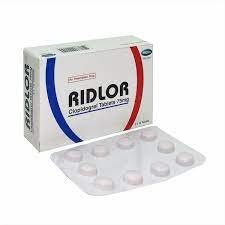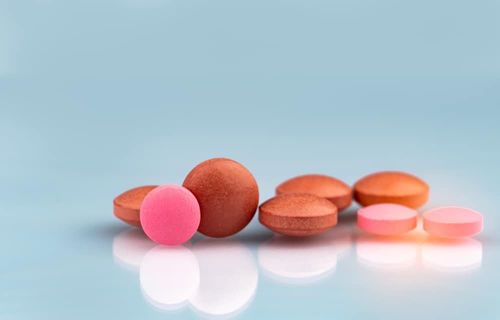This is an automatically translated article.
Cadigrel is manufactured and registered by Cadila Pharmaceuticals Ltd., which belongs to the group of cardiovascular drugs. So what is Cadigrel used for and in what cases is it used? Please read the article below.
1. What is Cadigrel?
Cadigrel drug contains the main active ingredient is Clopidogrel (in the form of Clopidogrel bisulphate) with the content of 75mg, the excipient is just enough for 1 tablet. The drug is prepared in the form of film-coated tablets, packing specifications: 1 large box contains 3 small boxes, in 1 small box has 1 blister containing 10 tablets.
2. Effects of Cadigrel
Cadigrel is indicated for use in the following cases:
Indication Cadigrel for primary prevention of thromboembolic disorders such as ischemic stroke (can be used from 7 days to less than 6 months), myocardial infarction (can be used for several days or lasts less than 35 days after infarction), peripheral artery disease . Also indicated for secondary prevention and control in atherosclerotic patients with recent myocardial infarction, stroke, and established peripheral arterial disease. Used to treat patients with ST-segment elevation acute myocardial infarction, in combination with Acetylsalicylic acid in patients eligible for antithrombotic therapy; non-ST-segment elevation acute coronary syndrome (non-Q-wave myocardial infarction, unstable angina); The patient had a stent placed through a subcutaneous coronary intervention. The use of Cadigrel is not indicated in the following subjects:
Do not use for patients with hypersensitivity to any of the components of the drug, including Clopidogrel and other excipients contained in Cadigrel. Patients with medical conditions such as severe liver failure, bleeding or ulceration of the gastrointestinal tract. Contraindications to the drug Cadigrel must be understood as an absolute contraindication, that is, it is not possible to use Cadigrel for any reason in cases of contraindications.
3. How to use and dose Cadigrel
How to take Cadigrel:
Cadigrel is produced in the form of tablets that should be taken orally. Food does not affect Cadigrel, so it can be taken at any time. Dosage of Cadigrel:
For patients with a history of atherosclerosis: Take once a day with a content of 75mg. The prophylactic dose used to prevent thromboembolic disorders such as stroke, peripheral artery disease, myocardial infarction is: 75 mg/day. Treatment of acute coronary syndrome: The initial dose should be 300mg, used in a single time, then use a daily maintenance dose of 75mg. For patients with renal impairment or the elderly: No dose adjustment of Cadigrel is required. In myocardial infarction with ST elevation: The initial dose of Cadigrel should be 300 mg, then return to a daily maintenance dose of 75 mg, in combination with Acetylsalicylic acid, with or without antithrombotic drugs. . When there is a combination therapy should be started early, as soon as symptoms and continued treatment for a minimum of 4 weeks. The starting dose is not applicable to patients over 75 years of age. Overdose and treatment:
Patients need to follow and apply the exact dose of Cadigrel prescribed by their doctor. Do not arbitrarily change the dose or calculate the application of another dose by yourself. Cadigrel overdose can prolong bleeding time leading to bleeding complications. Symptoms of acute poisoning include dyspnea, fatigue, vomiting, and gastrointestinal bleeding. In case of overdose, it is recommended that the patient immediately notify the treating doctor. There is currently no antidote to the activity of Clopidogrel, but the patient will be instructed to handle and treat promptly. minimize possible complications.
4. Undesirable effects
Although Cadigrel is easily tolerated, besides the effects of the drug, patients may experience unwanted effects during treatment.
Common side effects: itching, erythema, abdominal pain, diarrhea, nausea, dyspepsia. Less common side effects: Nosebleeds, chest tightness. More rare side effects to watch out for: Gastric ulcer, gastrointestinal bleeding, severe agranulocytosis, neutropenia, thrombocytopenia, aplastic anemia, purpura thrombocytopenia, kidney disease such as nephrotic syndrome, acute arthritis, loss of taste. Other side effects: intracranial hemorrhage, thrombocytopenia, ocular haemorrhage. Usually the side effects will disappear when the patient stops using the drug, however, to ensure safety and maintain the effectiveness of treatment, it is recommended that patients immediately report the side effects to their doctor. promptly treated.
5. Cadigrel drug interactions
Drugs when combined with Cadigrel can increase the risk of bleeding such as: Heparin, Warfarin, Aspirin, caution should be exercised when there is a combination of these drugs. The risk of potential gastrointestinal bleeding is increased when Cadigrel is combined with NSAIDs. Care should be taken when combining Cadigrel with drugs metabolised by the Cytochrome P450 system: Tamoxifen, Warfarin, Phenytoin, Torsemid, Tolbutamide, Fluvastatin and NSAIDs because the active ingredient Clopidogrel contained in Cadigrel inhibits Cytochrome P450. The concentration of the active metabolite Clopidogrel is decreased when Cadigrel is co-administered with drugs that inhibit CYP2C19 enzyme activity such as: Esomeprazole, Omeprazole, Fluoxetine, Voriconazole, Fluvoxamine, Moclobemide, Fluconazole, Ciprofloxacin, Ticlopidine, Carbamazepine, Cimetidine , Chloramphenicol and Oxcarbazepine.
6. Use Cadigrel with caution
Cadigrel must be discontinued for at least 5 days for patients preparing for surgery. In patients with bleeding due to surgery, trauma or other pathology, caution should be exercised during the use of Cadigrel. In patients with changes in metabolism (poor metabolism due to CYP2C19), patients with hepatic impairment should be careful before appointing Cadigrel. In the subjects that are pregnant and lactating women, there are no complete reports, so Cadigrel should not be used in these subjects, only used when absolutely necessary and consider the benefits of treatment as well as treatment. as possible adverse effects.
7. Preservation of Cadigrel
Store Cadigrel medicine in a cool, dry place, avoid direct sunlight exposure, the appropriate temperature is from 25 to 30oC. Keep Cadigrel out of reach of children and pets.
The article has provided information about the uses, dosage and precautions when using Cadigrel. To ensure safety for your health and maximize the effectiveness of your treatment, you need to take Cadigrel exactly as directed by your doctor.
Please dial HOTLINE for more information or register for an appointment HERE. Download MyVinmec app to make appointments faster and to manage your bookings easily.













